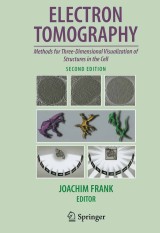Details

Electron Tomography
Methods for Three-Dimensional Visualization of Structures in the Cell2nd ed. 2006
|
234,33 € |
|
| Verlag: | Springer |
| Format: | |
| Veröffentl.: | 05.03.2008 |
| ISBN/EAN: | 9780387690087 |
| Sprache: | englisch |
| Anzahl Seiten: | 456 |
Dieses eBook enthält ein Wasserzeichen.
Beschreibungen
<P>This definitive work provides a comprehensive treatment of the mathematical background and working methods of three-dimensional reconstruction from tilt series. Special emphasis is placed on the problems presented by limitations of data collection in the transmission electron microscope. </P>
<P>The book, extensively revised and updated, takes the reader from biological specimen preparation to three-dimensional images of the cell and its components. </P>
<P>The book, extensively revised and updated, takes the reader from biological specimen preparation to three-dimensional images of the cell and its components. </P>
<P>Electron tomography has become a standard technique with applications in cell biology, structural biology, and materials science. This definitive work provides a comprehensive treatment of the mathematical background and working methods of three-dimensional reconstruction from tilt series, with special emphasis on the problems presented by limitations of data collection in the transmission electron microscope. In addition to chapters that are applicable to 3D reconstruction in all fields of science, such as radiological imaging in medicine and electron tomography in materials science, Electron Tomography also focuses on specimen preparation and imaging unique to biological electron microscopy. </P>
<P>This extensively revised second edition updates key contributions on the mathematics of 3D reconstruction, and includes new topics such as automated tomography, frozen sectioning of cells, and the interpretation of density maps through methods of fitting, docking, denoising, and segmentation. Each chapter is a self-contained treatise by a world expert in the author's field of research, resulting in an indispensable resource and companion for laboratories that practice electron tomography or seek to implement electron tomography as a tool for visualization of cells and cell components. </P>
<P> Key Features</P>
<UL>
<LI>Presents the mathematical background and working methods for three-dimensional reconstruction from projections </LI>
<LI>Takes the reader from biological specimen preparation to three-dimensional images of the cell and its components </LI>
<LI>Revised and updated extensively from the first edition published in 1992 </LI>
<LI>The definitive work in the field written by leading international experts</LI></UL>
<P>This extensively revised second edition updates key contributions on the mathematics of 3D reconstruction, and includes new topics such as automated tomography, frozen sectioning of cells, and the interpretation of density maps through methods of fitting, docking, denoising, and segmentation. Each chapter is a self-contained treatise by a world expert in the author's field of research, resulting in an indispensable resource and companion for laboratories that practice electron tomography or seek to implement electron tomography as a tool for visualization of cells and cell components. </P>
<P> Key Features</P>
<UL>
<LI>Presents the mathematical background and working methods for three-dimensional reconstruction from projections </LI>
<LI>Takes the reader from biological specimen preparation to three-dimensional images of the cell and its components </LI>
<LI>Revised and updated extensively from the first edition published in 1992 </LI>
<LI>The definitive work in the field written by leading international experts</LI></UL>
Introduction: Principles of Electron Tomography.- Sample Shrinkage and Radiation Damage of Plastic Sections.- Electron Tomography of Frozen-hydrated Sections of Cells and Tissues.- The Electron Microscope as a Structure Projector.- Cryotomography: Low-dose Automated Tomography of Frozen-hydrated Specimens.- Fiducial Marker and Hybrid Alignment Methods for Single- and Double-axis Tomography.- Markerless Alignment in Electron Tomography.- Algorithms for Three-dimensional Reconstruction From the Imperfect Projection Data Provided by Electron Microscopy.- Weighted Back-projection Methods.- Reconstruction With Orthogonal Functions.- Resolution in Electron Tomography.- Denoising of Electron Tomograms.- Segmentation of Three-dimensional Electron Tomographic Images.- Segmentation of Cell Components Using Prior Knowledge.- Motif Search in Electron Tomography.- Localization and Classification of Repetitive Structures in Electron Tomograms of Paracrystalline Assemblies.
<P>Electron tomography has become a standard technique with applications in cell biology, structural biology, and materials science. This definitive work provides a comprehensive treatment of the mathematical background and working methods of three-dimensional reconstruction from tilt series, with special emphasis on the problems presented by limitations of data collection in the transmission electron microscope. In addition to chapters that are applicable to 3D reconstruction in all fields of science, such as radiological imaging in medicine and electron tomography in materials science, <EM>Electron Tomography</EM> also focuses on specimen preparation and imaging unique to biological electron microscopy. </P>
<P>This extensively revised second edition updates key contributions on the mathematics of 3D reconstruction, and includes new topics such as automated tomography, frozen sectioning of cells, and the interpretation of density maps through methods of fitting, docking, denoising, and segmentation. Each chapter is a self-contained treatise by a world expert in the author's field of research, resulting in an indispensable resource and companion for laboratories that practice electron tomography or seek to implement electron tomography as a tool for visualization of cells and cell components. </P>
<P>This extensively revised second edition updates key contributions on the mathematics of 3D reconstruction, and includes new topics such as automated tomography, frozen sectioning of cells, and the interpretation of density maps through methods of fitting, docking, denoising, and segmentation. Each chapter is a self-contained treatise by a world expert in the author's field of research, resulting in an indispensable resource and companion for laboratories that practice electron tomography or seek to implement electron tomography as a tool for visualization of cells and cell components. </P>
<p>Presents the mathematical background and working methods for three-dimensional reconstruction from projections</p><p>Takes the reader from biological specimen preparation to three-dimensional images of the cell and its components</p><p>Revised and updated extensively from the first edition published in 1992</p><p>The definitive work in the field written by leading international experts</p>

















